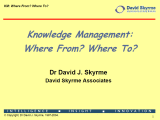Smarter Strategies
Most organizations have a strategic plan. However is it a smart plan? Does it ooze knowledge and KM? Is it an actively used guide for decision making and day-to-day operations, or is it a once a year exercise that results in shelfware? Likewise knowledge strategies need to be far more explicit in how they integrate into business strategies and how they support strategic decision making. Therefore the two-way links need to be made more explicit.

Over time the strength of these linkage will increase through three levels:
- Alignment - the two strategies take account of each other and are congruent; there is nothing that clashes
- Integration - knowledge is an integral part of the corporate strategy and vice versa; they were developed collaboratively
- Embedded - KM is embedded into every activity of the business.
So at the beginning it's the standard chicken and egg question: which comes first - the corporate/business strategy or the KM strategy? There are examples of both.
Starting with the Business Strategy
Professor Michael Zack suggests one approach for making the link more explicit.1 An organization must map its strategic knowledge and classify it according to its ability to confer a strategic advantage:
- Core knowledge - the minimum essential knowledge simply to participate in a given industry
- Advanced knowledge - superior knowledge that differentiates it from competitors
- Innovative knowledge - that enables an organization to be a market leader, often changing "the rules of the game".
Note that Zack's starting point is mapping knowledge, for example using the techniques of a knowledge audit. However, the focus is not on knowledge per se, but rather its identifying and categorising what knowledge is needed to succeed in a marketplace.
A more direct approach is to review your organization's business strategy and apply a knowledge lens to it. Each objective and activity in the corporate strategic plan is critically examined to identify the core knowledge inputs, processes and outputs. For example, an objective to improve customer service may imply:
- Knowledge inputs - developing systems to capture customer feedback, understand their needs, record transactions and conversations
- Knowledge processing - these activities may include analysis of the above data, discerning trends and patterns, customer dialogue events, staff development and training
- Knowledge outputs - specifications for product or service improvements, problem-solution databases and better user guides.
Starting with the Knowledge Strategy
On the other hand, if knowledge is viewed as a strategic resource, then why not identify which knowledge your organization possesses and build your business strategies around that? This approach has a good pedigree with roots going back to the identification of the 'core competencies' of an organization.2 One of the earlierst KM case studies, Dow Chemical, started with an inventory of its intellectual property and from that developed a programme that exploited these assets through means such as licencing.
In common with other enterprise-wide initiatives, what often starts with a particular focus often raises fundamental questions about overall business strategy and direction. Companies who have introduced performance measurement systems, for instance, have often found the need to probe for extra clarity around the areas of strategic vision and business priorities. Likewise, those embarking on developing knowledge or intellectual capital measures typically find that the dialogue generated between senior managers identifies possible future scenarios of how markets, technology and their own business strategies could evolve. In many cases it also identifies under-utilized or under-exploited knowledge assets.
The Best Of Both Worlds
In summary, the most effective approaches are those which involved an active interplay of both business and knowledge strategy development. On the one hand you need well articulated business strategies from which you can identify what knowledge you need to excel in them. On the other hand you should probe to understand what knowledge assets you have and how they create value to develop knowledge-enhanced business strategies based around your existing, but perhaps not well understood, 'core competencies'.
Here are some practical ways to 'smarten' your corporate strategy and to integrate it with your knowledge strategy:
- Identify what knowledge is crucial to support your business objectives
- Assess what you have now: its availability, quality and uniqueness
- Delve deep to really understand how knowledge contributes to creating value for your customers
- Review the outputs of your knowledge audit; look for gaps and duplication; are their areas where your high quality knowledge can be better explooited?
- Ensure that each business unit's functional plan has an explicit KM element and has identified KM people and resources
- Make sure that your corporate strategy explicitly addresses knowledge and KM
- Make sure that your KM strategy clearly identifies and show the links to how KM will improve organizational outcomes (business objectives)
- Manage the development and review of these strategies in an integrated timetable.
Notes
1. 'Developing a Knowledge Strategy', Michael H Zack, California Management Review, Vol. 41, No. 3, pp. 125-145 (Spring 1999).
2. 'The core competence of the corporation', C. K. Prahalad and G. Hamel, Harvard Business Review, Vol. 68, No. 3, pp. 79–91 (1990).
Last updated: 19th March 2011


